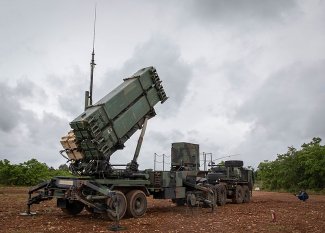The American support package for Ukraine. Day 789 of the war


The Russians are continuing their attacks in the Donbas, primarily in the areas around Marinka and Avdiivka, as well as to the east of Chasiv Yar. They have achieved the most notable success in the village of Ocheretyne, most of which they have now captured. Since the capture of Avdiivka two months ago, the invading troops have moved about 8 km deeper into Ukrainian positions in this direction, attacking along the Avdiivka-Pokrovsk railway line. So far, this is only a tactical success, but it has given the invaders the opportunity to launch an assault on the enemy’s flanks and weaken their defences along the adjacent sections of the front.
After several months of fighting, the Russians have also (at the cost of huge losses) captured Novomykhailivka, a town whose pre-war population was around 1400, which is located 7 km from the 2014 line of demarcation. The Ukrainian 79th Air Assault Brigade, which has been fighting there, has published a video showing the redeployment of the battle line in the area over the past six months, as well as over 300 pieces of destroyed enemy equipment, mainly tanks and various types of armoured vehicles.
The capture of Novomykhailivka and Ocheretyne has not fundamentally changed the situation on the front. The invaders are maintaining a small but steady rate of advance, which amounts to a few hundred metres per day at most. This is facilitated by the absence of major towns with high buildings or industrial plants on which the Ukrainians could base their defence. Its effectiveness will largely depend on how well the fortifications in the next positions have been prepared; these are mostly located among fields, and in some sections are only reinforced by water obstacles.

In recent days the intensity of Russian airstrikes against Ukraine has decreased compared to the period between 9 and 16 April (see ‘Russian attacks on energy systems intensify. Day 782 of the war’). The invaders launched a mass strike with missiles and drones on only one occasion: on 19 April it used 14 Shahed 131/136 drones and 22 missiles of various types; the Ukrainian anti-aircraft defence shot down all the drones and 15 of the cruise missiles. The main targets were sites located in the Dnipro and Dnipropetrovsk oblasts. In addition, the Russians carried out several precision attacks: Odesa was struck twice, and on 17 April Chernihiv was hit by three Iskander ballistic missiles. In the latter city the building of a former hotel, which probably housed a Ukrainian army command post and communications hub, was destroyed.

On 20 April, the US House of Representatives passed a supplemental bill with military and financial assistance for Ukraine. It has now been voted through in the Senate, and should imminently be signed into law by President Joe Biden. In terms of military aid, the bill primarily provides for a pool of $7.8bn in Presidential Drawdown Authority (PDA), which allows for the immediate transfer of weapons and military equipment to Kyiv from Department of Defense (DoD) stockpiles, and around $13.8bn under the Ukraine Security Assistance Initiative (USAI), which allows for the procurement of new weapons for the country from the arms industry. Kyiv will receive around $7.85bn in budget support in the form of a loan that can be cancelled.
One section of the bill obliges the president to transfer ATACMS ballistic missiles to Ukraine as soon as practicable, without specifying which version is to be delivered; at the same time, the head of state has the right to withhold the transfer. An older version of the ATACMS missiles (M39), which have a shorter range (165 km), had already been delivered to Kyiv, but the newer versions have a range of up to 300 km. Ukraine’s president Volodymyr Zelensky said on 22 April that he had reached an agreement with Biden on the delivery of the newer versions of the ATACMSs.
On 19 April, Ukrainian PM Denys Shmyhal unveiled plans for the use of US financial aid. Of a total of $60.8bn, $49.9bn will be allocated to defence spending, $7.8bn for support of the state budget, $1.57bn for economic aid, including the reconstruction of critical infrastructure, and $400m for border protection and demining.
On 22 April, on the eve of his visit to Poland, British PM Rishi Sunak announced the largest aid package to date for Ukraine, worth £500 million. A total of 60 boats including offshore raiding craft, rigid raiding craft and dive boats as well as maritime guns, more than 1600 strike and air defence missiles, as well as additional Storm Shadow long-range precision-guided missiles, 160 protected mobility ‘Husky’ vehicles, 162 armoured vehicles of unspecified types and 78 all-terrain vehicles of unspecified types and 4 million small arms ammunition will also be handed over.
On 16 April, the Danish government presented its 17th aid package to Kyiv, worth €26.8 million. It plans to purchase arms & ammunition and drones for the Ukrainian arms industry in cooperation with the Czech Republic and the Netherlands. During a visit to Ukraine on 18 April, the German vice-chancellor and minister of the economy Robert Habeck opened a drone factory of the German company Quantum-Systems. It currently employs 25 people, but this number is expected to rise to 100 by the end of the year. The factory will increase Quantum-Systems’ overall production capacity to around 1000 drones per year.
During the NATO-Ukraine Council on 19 April, Germany presented an initiative to strengthen Ukraine’s air defence. Under this plan, called Immediate Action on Air Defence (IAAD), further batteries of air defence systems would be transferred to Kyiv in the short term. Countries would also have the option to allocate funds for the purchase of munitions. Germany has also pledged to deliver one Patriot battery (the third in succession). The Netherlands has promised €150 million, as well as the purchase of very short-range systems for a further €60 million. Denmark also expressed its willingness to participate financially in IAAD, but no specifics were given. Lithuania has announced its participation, as well as its intention to provide air surveillance radars.

On the night of 16–17 April, the Ukrainians carried out a successful missile strike against the Dzhankoi airbase in the north of Crimea. According to the Main Intelligence Directorate, among the targets destroyed were four S-400 Triumf anti-aircraft launchers. If this report is confirmed, this would represent another successful attack on the air defence system and Russian command points on the peninsula. This demonstrates the commitment to the plan to neutralise missile defences in Crimea, which would make it easier to use cruise missiles to strike Black Sea Fleet bases and other military facilities.
On 19 April, a Russian Tu-22M3 bomber crashed in Stavropol krai and some of the crew were killed. The causes are unclear: according to Ukraine the aircraft was shot down by a modified S-200 anti-aircraft missile, while the Russians claim the crash was caused by a technical fault. According to British military intelligence, the invaders have lost more than 100 combat aircraft since the start of the war.
On the night of 19–20 April, the Ukrainians attacked the enemy with long-range drones. According to a communiqué from the Russian defence ministry, 50 drones were shot down, mainly in the Belgorod, Kursk and Bryansk oblasts. Some drones penetrated the air defence barrage and hit elements of the energy infrastructure, but the scale of the damage is unknown.
On 21 April, the salvage ship Komuna, which the Russian navy had been using since 1915, was damaged by a Ukrainian cruise missile while it was moored in a harbour in Sevastopol.

Strikes against Ukrainian TV. On 17 April, the Ukrainian media group 1+1 confirmed that Russia has been disrupting satellite TV reception in Ukraine since the end of March. It said that transmissions on the Astra 4A and Hotbird13E and 13G transponders were temporarily unavailable. Instances of enemy propaganda programmes being broadcast after taking control of Ukrainian frequencies have also been reported.
Psychological operations. On 22 April the head of Ukrainian military intelligence Kyrylo Budanov announced that Russian special services were seeking to stoke social tensions in Ukraine as part of what is known as ‘Operation Maidan-3’. The methods designed to increase public disillusionment with the effectiveness of the Ukrainian government’s actions include delaying POW swaps.
Estimates of energy infrastructure losses. On 22 April, the energy conglomerate DTEK announced that it estimated the cost of restoring power lost due to the shelling of thermal power plants at US$350 million. It announced that there would be electricity shortages during peak consumption periods in summer and winter. The gas turbines available can only be used to cover critical needs such as powering hospitals.

On 23 April, the head of the foreign ministry Dmytro Kuleba announced the suspension of consular services for Ukrainian citizens of conscription age residing abroad. He recalled that citizens had been obliged to update their data at the military commissions even before the adoption of the recent amendments to the mobilisation legislation. The government wants the ban on consular services for men who do not have a military registration certificate to force them to return to the country, for example if their passport expires.
In the past week, Ukraine’s military-political leadership has reported on the growing production capacity of the arms industry. On 18 April, President Zelensky announced that the army would receive 10 Bohdan self-propelled howitzers by the end of the month. In turn, defence minister General Oleksandr Syrskyi attended a presentation of new types of armoured personnel carriers. However, there is no evidence that domestic equipment has yet reached the battlefield in significant numbers. This is especially true of the Bohdans mentioned above, regular production of which was supposed to have started a few months ago. So far, the only major and confirmed success story of the Ukrainian arms industry is long-range air and sea drones. According to the Economist, work on producing drones with a range of up to 3000 km is underway.
Defence budget outlays. On 22 April, the Ukrainian finance ministry reported that expenditure on the security and defence sector amounted to more than 408 billion hryvnias (c. $10.2bn) from January to March this year. These funds were used for cash allowances for military personnel and police officers, as well as the purchase of weapons, ammunition, personal protective equipment (helmets, bulletproof vests), fuels, lubricants and food.





